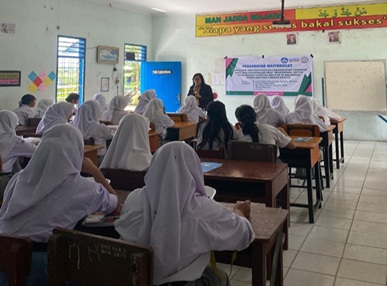Pengenalan dan Penyuluhan Tanaman Obat Tradisional untuk Diabetes Melitus pada Siswa SMK PAB-3 Medan Estate Introduction and Counseling of Traditional Medicinal Plants for Diabetes Mellitus to SMK PAB-3 Medan Estate Students
Main Article Content
Abstract
Diabetes is a disease that is a problem in the world, and Indonesia had the fifth-highest prevalence of diabetes in the world in 2021 with 19.47 million patients. One of the efforts that can be made to treat diabetes mellitus is with traditional medicine that comes from nature. The purpose of this community service activity is to increase the understanding of knowledge about diabetes mellitus and the use of traditional medicinal plants as therapy for diabetes mellitus. This community service method uses an educational method with the target being students of SMK PAB-3 Medan Estate. In the initial stage, a pretest session was conducted, followed by an education session related to the knowledge of diabetes mellitus and the utilization of traditional medicinal plants. In the final stage, a post-test was conducted. The results of this community service show that there is an increase in community knowledge before education, which is 40%, increasing after education by 60%.
Downloads
Article Details

This work is licensed under a Creative Commons Attribution-ShareAlike 4.0 International License.
Authors who publish with this journal agree to the following terms:
- Any article on the copyright is retained by the author(s).
- Author grant the journal, right of first publication with the work simultaneously licensed under a Creative Commons Attribution License that allows others to share work with acknowledgment of the work authors and initial publications in this journal.
- Authors are able to enter into a separate, additional contractual arrangements for non-exclusive distribution of published articles of work (eg, post-institutional repository) or publish it in a book, with acknowledgment of its initial publication in this journal.
- Authors are permitted and encouraged to post their work online (e.g., in institutional repositories or on their websites) prior to and during the submission process, as can lead to productive exchanges, as well as earlier and greater citation of published work.
- The article and any associated published material is distributed under the Creative Commons Attribution-ShareAlike 4.0 International License
References
ADA (American Diabetes Association). (2020). Standard of Medical Care in Diabetes 2020. Volume 43. www.DiAbetes.org/DiAbetescAre
De Sales, P. M., Souza, P.M., Simeoni, L., Megalhaes, P., dan Seilveira. (2012). α amylase Inhibitors: A Review of Raw Material and Isolated Compounds from Plant Source. J. Pharm. Pharmaceut. Sci. 15(1): 141 – 183. https://doi.org/10.18433/j35s3k
Decroli, E. (2019). Diabetes Melitus Tipe 2. Padang: Pusat Penerbitan Bagian Ilmu Penyakit Dalam Fakulltas Kedokteran Universitas Andalas. http://repo.unand.ac.id/21867/1/Buku%20Diabetes%20Melitus%20%28Lengkap%29.pdf
Dewi Ni Luh Kade Arman Anita, Prameswari Putu Nimas Dyiah, Cahyaningsiha Erna, Megawati Fitria, Agustini Ni Putu Dewi, Juliadi Debby. 2022. Review: Pemanfaatan Tanaman Sebagai Fitoterapi Pada Diabetes Mellitus. Usadha: Jurnal Integrasi Obat Tradisional 2(1). http://dx.doi.org/10.31604/jpm.v7i2.401-406
Fukai T, Ushio-fukai M. (2011). Superoxide Dismutases: Role in Redox Signaling, Vascular Function, and Diseases. Mary Ann Liebert, Inc. 15(6): 1583-1597. http://dx.doi.org/10.31604/jpm.v7i2.401-406
He, L., He, T., Farrar, S., Ji, L., Liu, T., Ma, X. (2017). Antioxidants Maintain Cellular Redox Homeostasis by Elimination of Reactive Oxygen Species. Cellular Physiology and Biochemistry 44:532-553. https://doi.org/10.1159/000485089
International Diabetes Federation (IDF). (2021). International Diabetic Federation. Diabetic Atlas 10th edition.
Kitukale, MD., Chandewar, A.V., 2014. An Overview on Some Recent Herbs Having Antidiabetic Potential. Research Journal of Pharmaceutical, Biological and Chemical Sciences. India. https://www.researchgate.net/publication/286836482_An_overview_on_some_recent_herbs_having_antidiabetic_potential
Pearce, E. (2013). Anatomi dan Fisiologi untuk Paramedis. Edisi 40. Jakarta: Gramedia Pustaka Utama. https://books.google.co.id/books/about/Anatomi_Dan_Fisiologi_Untuk_Paramedis.html?hl=id&id=55OShlTLNCMC&redir_esc=y
Putri, U. A. (2021). Narrative Review: Herbal Nanomedicine untuk Terapi Diabetes Melitus (Doctoral dissertation, Universitas Jenderal Soedirman). https://repository.unsoed.ac.id/10755/3/ABSTRAK-Ulfa%20Antoni%20Putri-I1C017014-Skripsi-2021.pdf
Ullah, A., Khan, A., Khan, I. (2016). Diabetes mellitus and oxidative stress––A concise review. Saudi Pharmaceutical Journal. 24: 547-553. https://doi.org/10.1016/j.jsps.2015.03.013
Zhao, Z., Han, Z., Naveena, K., Lei, G., Qiu, S., Li, X., et al. (2021). ROS-responsive Nanoparticle as a Berberine Carrier for OHC-Targeted Therapy of Noise Induced Hearing Loss. ACS Appl. Mater. Inter, 13, 7102–7114. https://doi.org/10.1021/acsami.0c21151
